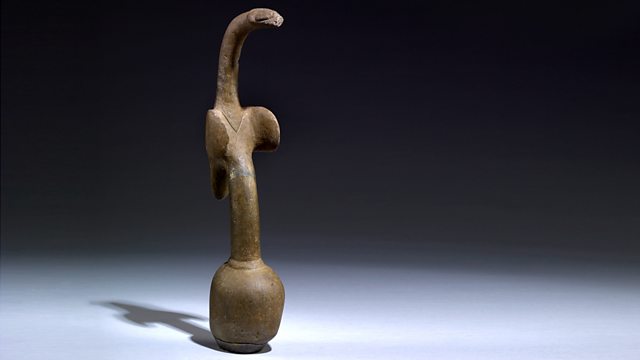Bird-shaped Pestle
Neil MacGregor, continues his series retelling humanity's history through the objects it has made. Today, he's investigating early attempts at cookery
Neil MacGregor continues his retelling of human history using 100 selected objects from the British Museum. This week he explores the profound changes that humans experienced at the end of the Ice Age. By this period, humanity is reconsidering its place in the world and turning its attention to food, power, worship, and human relationships.
But then, as now, one of the most important parts of human existence was finding enough food to survive. Taking a pestle from Papua New Guinea as an example, Neil asks why our ancestors decided to grow and cook new foods. The answer provides us with a telling insight into the way early humans settled on the land. Becoming farmers and eating food that was harder for other animals to digest made us a formidable force in the food chain. The impact on our environment of this shift to cookery and cultivation is still being felt.
Neil is joined by Indian food writer Madhur Jaffrey, campaigner Sir Bob Geldof and archaeologist Professor Martin Jones
Last on
More episodes
Previous
You are at the first episode
![]()
Discover more science & technology programmes within A History of the World in 100 Objects
About this object
Location: Aikora River, Papua New Guinea
Culture: Early People
Period: About 4-8,000 years-old
Material: Stone
This bird-shaped pestle was used by early farmers in Papua New Guinea, probably to grind the vegetable taro in a mortar. People in Papua New Guinea learnt how to grow crops 9000 years ago. Papua New Guinea was one of seven locations where farming independently developed after the last Ice Age. The pestle's long neck meant it was too delicate to be used regularly and its bird-shape suggests it may have been used for pounding food on special occasions.
When did humans start to farm?
Growing plants and raising animals is one of the most important developments in human history. It was a gradual change that took place over several thousand years about 10,000 years ago. Farming created an abundant food supply that for the first time could support larger populations. People began to settle in one place to grow crops rather than being constantly on the move searching for new food sources. This led to the creation of the first villages
Did you know?
- At about the time objects like this were used, Britain and Ireland were separated by rising sea levels
The mysteries of the bird pestle
By Pamela Swadling, Archaeologist, Australian National University
��
This stone pestle was found over 100 years ago by gold miners in the banks of the Aikora River in Oro in Papua New Guinea.
At the time of its discovery other stone pestles and stone mortars, or bowls, were being unearthed across British New Guinea and German New Guinea. What was intriguing was that the local people did not know when they were made or who had made them. Their history was a mystery.
Archaeology is now helping to reveal their story as some have been found among deposits of archaeological material. The dates of these deposits tell us that these artefacts were made and used between about 8,000 and 3,000 years ago.
The stone pestles and mortars are always found in areas where taro, an edible starchy tuber (or plant stem), can be grown. This tells us that the objects might have been used to pound cooked taro and local nut products into a rich edible paste. This dish is still prepared for feasts in a few predominately coastal areas of Papua New Guinea.
Unlike this pestle, the majority of pestles and mortars are undecorated. Most stone bird pestles have been found in Papua New Guinea. The largest cluster of finds comes from the shores of a former inland sea, which was in-filled about 4,000 years ago.
Curiously most of the birds sculpted on the handle tops of the pestles found in this cluster have their wings folded rather than raised like this stone bird pestle.
Birds sculpted with raised wings like this one have been discovered in other areas of the island instead, usually where only small numbers of other stone mortars and pestles have been found.
Many have been found on major pathways from the coast to highland valleys. Why this should be the case is not fully understood. It may be related to the trading of bird of paradise plumes between the highlands and the coast.
Ritual, religion, calories and stomachs
By Professor Graeme Barker, Archaeologist, University of Cambridge
��
New Guinea has one of the oldest histories of food production in the world. Soon after our species, Homo sapiens, arrived here around 40,000 years ago as part of their expansion out of Africa, they began exploiting plants like yams and taro.
Studies of fossil pollen show that they burnt forest to encourage the growth of these plants. Archaeologists have proposed the term ‘vegeculture’ for what these hunters and gatherers were doing.
By 10,000 BC people were draining land to make special gardens, and growing taro, as early as the earliest signs of farming in America, the Near East, and China. But what this enigmatic and slightly sinister object – part bird, part phallus - does is to remind us how producing food was as much about ritual and religion for most early farmers as it was about producing calories and filling stomachs.
It is one of a number of strangely ornate pestles known from New Guinea, collected like this one by European visitors in the nineteenth and early twentieth centuries. Many of them are probably prehistoric, but some were still being used at the time they were collected.
They were used for grinding up plants and seeds, but in recorded times this was often associated with making magical potions used in rain-making. Birds are still hugely important omens for people in New Guinea, their flight paths checked anxiously for whether they bring good luck or misfortune.
We might think that we compartmentalise food and faith, supermarket and church or mosque, but for us, too, just like the New Guinea farmers who used this pestle, coming together at the dinner table underpins all our social interactions and life ceremonies.
Transcript
Broadcasts
- Mon 25 Jan 2010 09:4591�ȱ� Radio 4 FM
- Mon 25 Jan 2010 19:4591�ȱ� Radio 4
- Tue 26 Jan 2010 00:3091�ȱ� Radio 4
- Mon 20 Apr 2020 13:4591�ȱ� Radio 4
Featured in...
![]()
Science and Technology—A History of the World in 100 Objects
A History of the World in 100 Objects - objects related to science and technology.
![]()
Food and Farming—A History of the World in 100 Objects
A History of the World in 100 objects - Food and farming
Podcast
-
![]()
A History of the World in 100 Objects
Director of the British Museum, Neil MacGregor, retells humanity's history through objects





